Assisted Suicide: An Argument Essay for RHET 1010 Course
VerifiedAdded on 2023/05/28
|8
|2226
|271
Essay
AI Summary
This essay delves into the highly contentious issue of assisted suicide, examining its ethical and legal dimensions. The author argues that assisted suicide should be permissible when a person is terminally ill or disabled with no hope of recovery, differentiating it from euthanasia by emphasizing the patient's control over the process. The essay counters arguments against assisted suicide, such as concerns about medical professionals becoming killers and the potential for societal approval of killing, while providing a case study of a patient with severe medical conditions to support the thesis. The conclusion reiterates that assisted suicide should be legally permissible under specific conditions and medical supervision.

Running head: ASSISTED SUICIDE
Assisted Suicide
Name of the Student
Name of the University
Author Note
Assisted Suicide
Name of the Student
Name of the University
Author Note
Paraphrase This Document
Need a fresh take? Get an instant paraphrase of this document with our AI Paraphraser
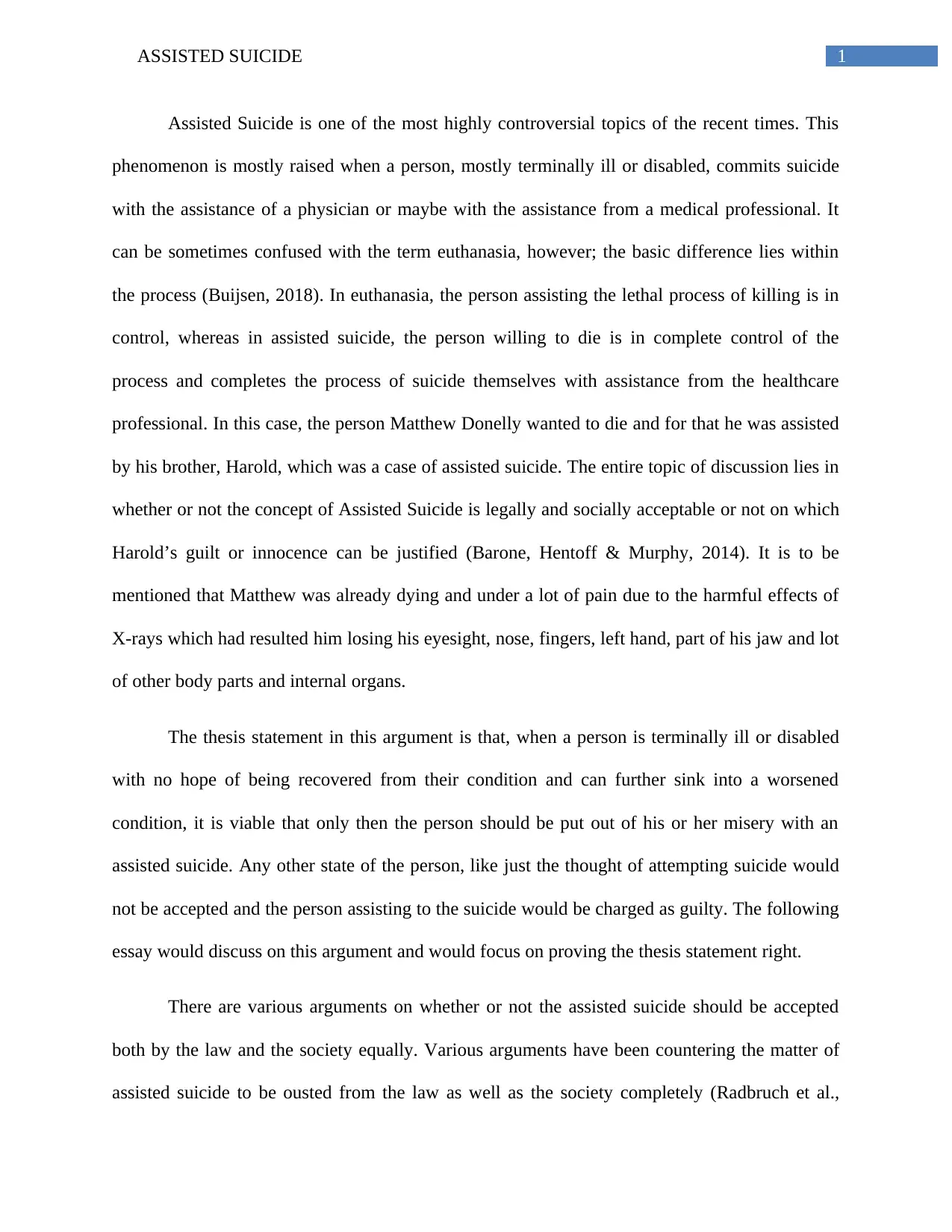
1ASSISTED SUICIDE
Assisted Suicide is one of the most highly controversial topics of the recent times. This
phenomenon is mostly raised when a person, mostly terminally ill or disabled, commits suicide
with the assistance of a physician or maybe with the assistance from a medical professional. It
can be sometimes confused with the term euthanasia, however; the basic difference lies within
the process (Buijsen, 2018). In euthanasia, the person assisting the lethal process of killing is in
control, whereas in assisted suicide, the person willing to die is in complete control of the
process and completes the process of suicide themselves with assistance from the healthcare
professional. In this case, the person Matthew Donelly wanted to die and for that he was assisted
by his brother, Harold, which was a case of assisted suicide. The entire topic of discussion lies in
whether or not the concept of Assisted Suicide is legally and socially acceptable or not on which
Harold’s guilt or innocence can be justified (Barone, Hentoff & Murphy, 2014). It is to be
mentioned that Matthew was already dying and under a lot of pain due to the harmful effects of
X-rays which had resulted him losing his eyesight, nose, fingers, left hand, part of his jaw and lot
of other body parts and internal organs.
The thesis statement in this argument is that, when a person is terminally ill or disabled
with no hope of being recovered from their condition and can further sink into a worsened
condition, it is viable that only then the person should be put out of his or her misery with an
assisted suicide. Any other state of the person, like just the thought of attempting suicide would
not be accepted and the person assisting to the suicide would be charged as guilty. The following
essay would discuss on this argument and would focus on proving the thesis statement right.
There are various arguments on whether or not the assisted suicide should be accepted
both by the law and the society equally. Various arguments have been countering the matter of
assisted suicide to be ousted from the law as well as the society completely (Radbruch et al.,
Assisted Suicide is one of the most highly controversial topics of the recent times. This
phenomenon is mostly raised when a person, mostly terminally ill or disabled, commits suicide
with the assistance of a physician or maybe with the assistance from a medical professional. It
can be sometimes confused with the term euthanasia, however; the basic difference lies within
the process (Buijsen, 2018). In euthanasia, the person assisting the lethal process of killing is in
control, whereas in assisted suicide, the person willing to die is in complete control of the
process and completes the process of suicide themselves with assistance from the healthcare
professional. In this case, the person Matthew Donelly wanted to die and for that he was assisted
by his brother, Harold, which was a case of assisted suicide. The entire topic of discussion lies in
whether or not the concept of Assisted Suicide is legally and socially acceptable or not on which
Harold’s guilt or innocence can be justified (Barone, Hentoff & Murphy, 2014). It is to be
mentioned that Matthew was already dying and under a lot of pain due to the harmful effects of
X-rays which had resulted him losing his eyesight, nose, fingers, left hand, part of his jaw and lot
of other body parts and internal organs.
The thesis statement in this argument is that, when a person is terminally ill or disabled
with no hope of being recovered from their condition and can further sink into a worsened
condition, it is viable that only then the person should be put out of his or her misery with an
assisted suicide. Any other state of the person, like just the thought of attempting suicide would
not be accepted and the person assisting to the suicide would be charged as guilty. The following
essay would discuss on this argument and would focus on proving the thesis statement right.
There are various arguments on whether or not the assisted suicide should be accepted
both by the law and the society equally. Various arguments have been countering the matter of
assisted suicide to be ousted from the law as well as the society completely (Radbruch et al.,
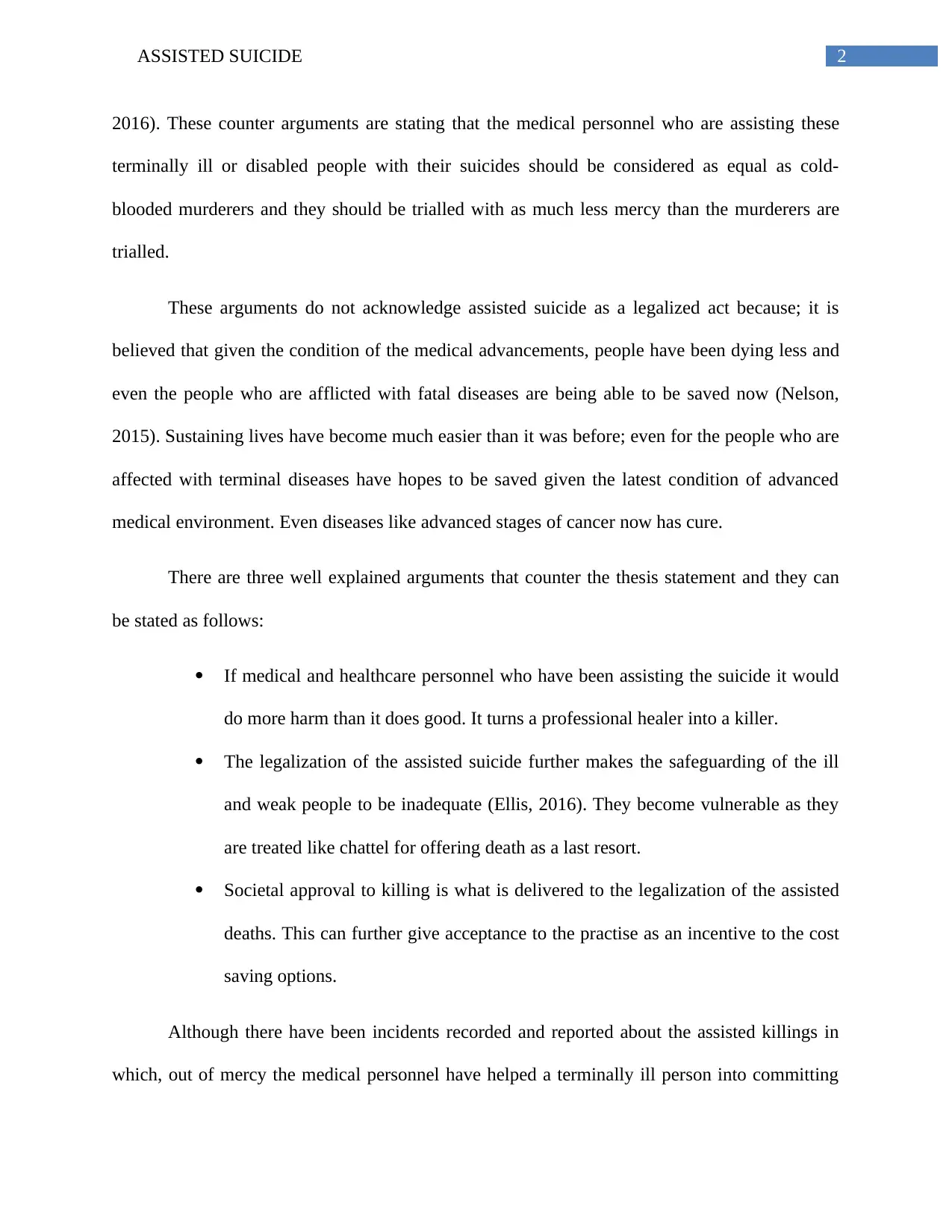
2ASSISTED SUICIDE
2016). These counter arguments are stating that the medical personnel who are assisting these
terminally ill or disabled people with their suicides should be considered as equal as cold-
blooded murderers and they should be trialled with as much less mercy than the murderers are
trialled.
These arguments do not acknowledge assisted suicide as a legalized act because; it is
believed that given the condition of the medical advancements, people have been dying less and
even the people who are afflicted with fatal diseases are being able to be saved now (Nelson,
2015). Sustaining lives have become much easier than it was before; even for the people who are
affected with terminal diseases have hopes to be saved given the latest condition of advanced
medical environment. Even diseases like advanced stages of cancer now has cure.
There are three well explained arguments that counter the thesis statement and they can
be stated as follows:
If medical and healthcare personnel who have been assisting the suicide it would
do more harm than it does good. It turns a professional healer into a killer.
The legalization of the assisted suicide further makes the safeguarding of the ill
and weak people to be inadequate (Ellis, 2016). They become vulnerable as they
are treated like chattel for offering death as a last resort.
Societal approval to killing is what is delivered to the legalization of the assisted
deaths. This can further give acceptance to the practise as an incentive to the cost
saving options.
Although there have been incidents recorded and reported about the assisted killings in
which, out of mercy the medical personnel have helped a terminally ill person into committing
2016). These counter arguments are stating that the medical personnel who are assisting these
terminally ill or disabled people with their suicides should be considered as equal as cold-
blooded murderers and they should be trialled with as much less mercy than the murderers are
trialled.
These arguments do not acknowledge assisted suicide as a legalized act because; it is
believed that given the condition of the medical advancements, people have been dying less and
even the people who are afflicted with fatal diseases are being able to be saved now (Nelson,
2015). Sustaining lives have become much easier than it was before; even for the people who are
affected with terminal diseases have hopes to be saved given the latest condition of advanced
medical environment. Even diseases like advanced stages of cancer now has cure.
There are three well explained arguments that counter the thesis statement and they can
be stated as follows:
If medical and healthcare personnel who have been assisting the suicide it would
do more harm than it does good. It turns a professional healer into a killer.
The legalization of the assisted suicide further makes the safeguarding of the ill
and weak people to be inadequate (Ellis, 2016). They become vulnerable as they
are treated like chattel for offering death as a last resort.
Societal approval to killing is what is delivered to the legalization of the assisted
deaths. This can further give acceptance to the practise as an incentive to the cost
saving options.
Although there have been incidents recorded and reported about the assisted killings in
which, out of mercy the medical personnel have helped a terminally ill person into committing
⊘ This is a preview!⊘
Do you want full access?
Subscribe today to unlock all pages.

Trusted by 1+ million students worldwide
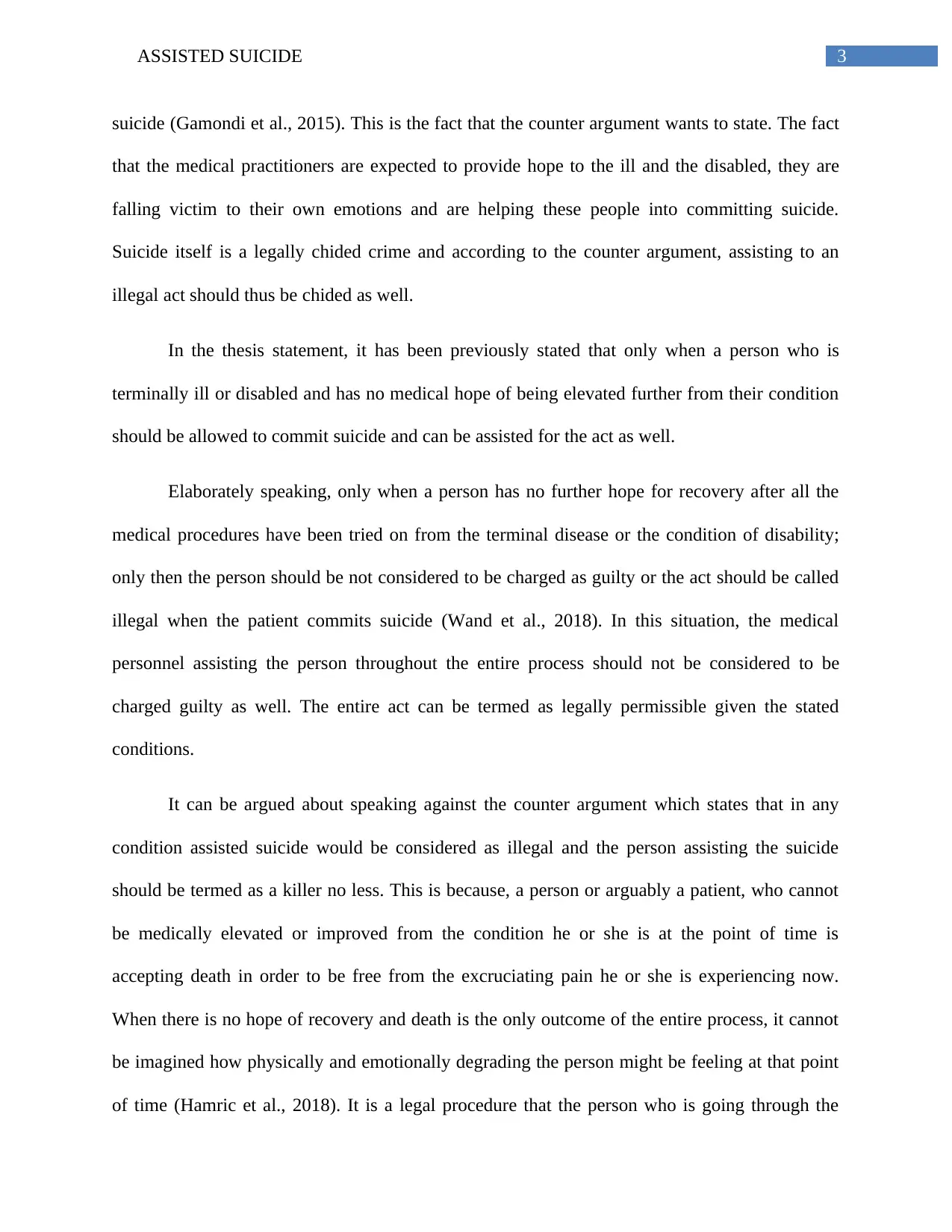
3ASSISTED SUICIDE
suicide (Gamondi et al., 2015). This is the fact that the counter argument wants to state. The fact
that the medical practitioners are expected to provide hope to the ill and the disabled, they are
falling victim to their own emotions and are helping these people into committing suicide.
Suicide itself is a legally chided crime and according to the counter argument, assisting to an
illegal act should thus be chided as well.
In the thesis statement, it has been previously stated that only when a person who is
terminally ill or disabled and has no medical hope of being elevated further from their condition
should be allowed to commit suicide and can be assisted for the act as well.
Elaborately speaking, only when a person has no further hope for recovery after all the
medical procedures have been tried on from the terminal disease or the condition of disability;
only then the person should be not considered to be charged as guilty or the act should be called
illegal when the patient commits suicide (Wand et al., 2018). In this situation, the medical
personnel assisting the person throughout the entire process should not be considered to be
charged guilty as well. The entire act can be termed as legally permissible given the stated
conditions.
It can be argued about speaking against the counter argument which states that in any
condition assisted suicide would be considered as illegal and the person assisting the suicide
should be termed as a killer no less. This is because, a person or arguably a patient, who cannot
be medically elevated or improved from the condition he or she is at the point of time is
accepting death in order to be free from the excruciating pain he or she is experiencing now.
When there is no hope of recovery and death is the only outcome of the entire process, it cannot
be imagined how physically and emotionally degrading the person might be feeling at that point
of time (Hamric et al., 2018). It is a legal procedure that the person who is going through the
suicide (Gamondi et al., 2015). This is the fact that the counter argument wants to state. The fact
that the medical practitioners are expected to provide hope to the ill and the disabled, they are
falling victim to their own emotions and are helping these people into committing suicide.
Suicide itself is a legally chided crime and according to the counter argument, assisting to an
illegal act should thus be chided as well.
In the thesis statement, it has been previously stated that only when a person who is
terminally ill or disabled and has no medical hope of being elevated further from their condition
should be allowed to commit suicide and can be assisted for the act as well.
Elaborately speaking, only when a person has no further hope for recovery after all the
medical procedures have been tried on from the terminal disease or the condition of disability;
only then the person should be not considered to be charged as guilty or the act should be called
illegal when the patient commits suicide (Wand et al., 2018). In this situation, the medical
personnel assisting the person throughout the entire process should not be considered to be
charged guilty as well. The entire act can be termed as legally permissible given the stated
conditions.
It can be argued about speaking against the counter argument which states that in any
condition assisted suicide would be considered as illegal and the person assisting the suicide
should be termed as a killer no less. This is because, a person or arguably a patient, who cannot
be medically elevated or improved from the condition he or she is at the point of time is
accepting death in order to be free from the excruciating pain he or she is experiencing now.
When there is no hope of recovery and death is the only outcome of the entire process, it cannot
be imagined how physically and emotionally degrading the person might be feeling at that point
of time (Hamric et al., 2018). It is a legal procedure that the person who is going through the
Paraphrase This Document
Need a fresh take? Get an instant paraphrase of this document with our AI Paraphraser
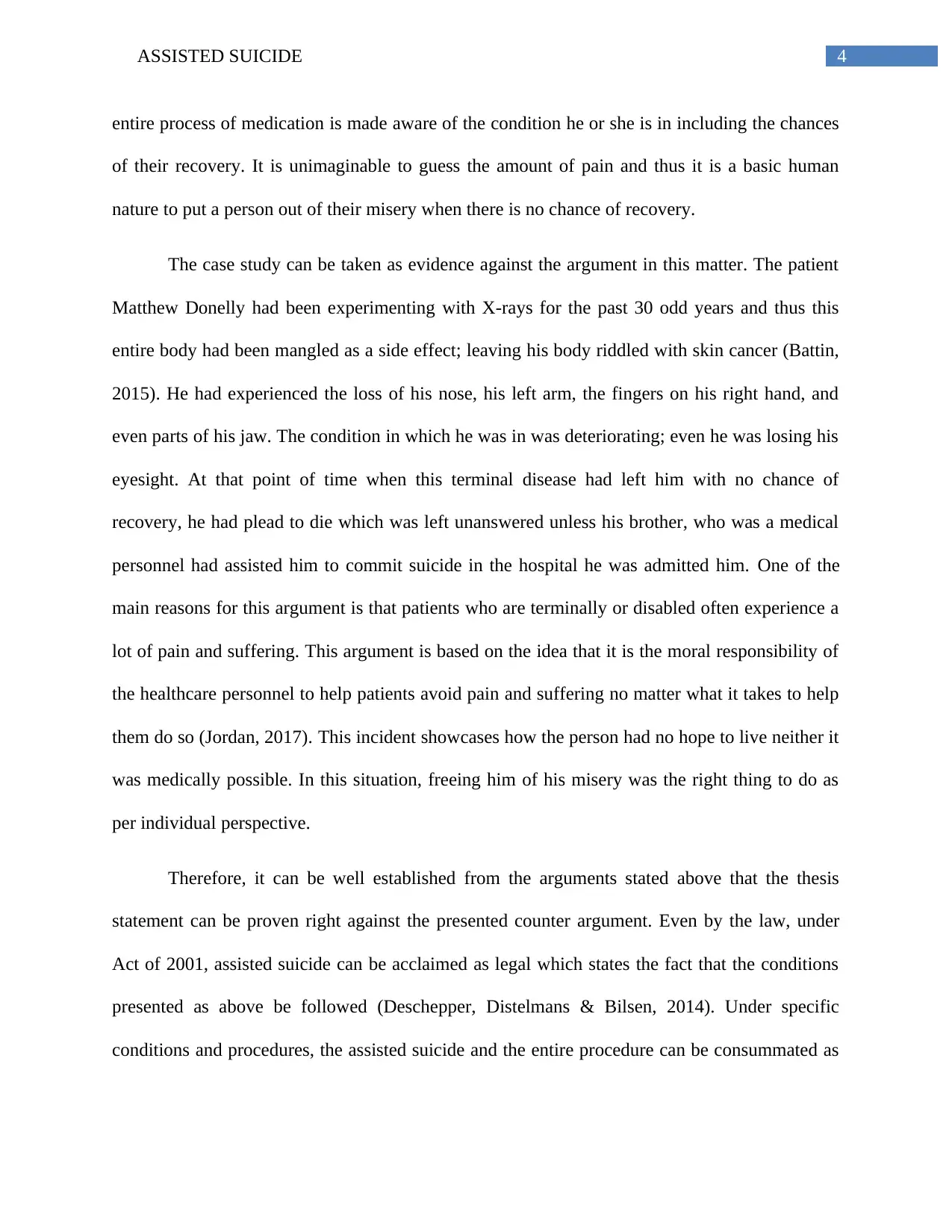
4ASSISTED SUICIDE
entire process of medication is made aware of the condition he or she is in including the chances
of their recovery. It is unimaginable to guess the amount of pain and thus it is a basic human
nature to put a person out of their misery when there is no chance of recovery.
The case study can be taken as evidence against the argument in this matter. The patient
Matthew Donelly had been experimenting with X-rays for the past 30 odd years and thus this
entire body had been mangled as a side effect; leaving his body riddled with skin cancer (Battin,
2015). He had experienced the loss of his nose, his left arm, the fingers on his right hand, and
even parts of his jaw. The condition in which he was in was deteriorating; even he was losing his
eyesight. At that point of time when this terminal disease had left him with no chance of
recovery, he had plead to die which was left unanswered unless his brother, who was a medical
personnel had assisted him to commit suicide in the hospital he was admitted him. One of the
main reasons for this argument is that patients who are terminally or disabled often experience a
lot of pain and suffering. This argument is based on the idea that it is the moral responsibility of
the healthcare personnel to help patients avoid pain and suffering no matter what it takes to help
them do so (Jordan, 2017). This incident showcases how the person had no hope to live neither it
was medically possible. In this situation, freeing him of his misery was the right thing to do as
per individual perspective.
Therefore, it can be well established from the arguments stated above that the thesis
statement can be proven right against the presented counter argument. Even by the law, under
Act of 2001, assisted suicide can be acclaimed as legal which states the fact that the conditions
presented as above be followed (Deschepper, Distelmans & Bilsen, 2014). Under specific
conditions and procedures, the assisted suicide and the entire procedure can be consummated as
entire process of medication is made aware of the condition he or she is in including the chances
of their recovery. It is unimaginable to guess the amount of pain and thus it is a basic human
nature to put a person out of their misery when there is no chance of recovery.
The case study can be taken as evidence against the argument in this matter. The patient
Matthew Donelly had been experimenting with X-rays for the past 30 odd years and thus this
entire body had been mangled as a side effect; leaving his body riddled with skin cancer (Battin,
2015). He had experienced the loss of his nose, his left arm, the fingers on his right hand, and
even parts of his jaw. The condition in which he was in was deteriorating; even he was losing his
eyesight. At that point of time when this terminal disease had left him with no chance of
recovery, he had plead to die which was left unanswered unless his brother, who was a medical
personnel had assisted him to commit suicide in the hospital he was admitted him. One of the
main reasons for this argument is that patients who are terminally or disabled often experience a
lot of pain and suffering. This argument is based on the idea that it is the moral responsibility of
the healthcare personnel to help patients avoid pain and suffering no matter what it takes to help
them do so (Jordan, 2017). This incident showcases how the person had no hope to live neither it
was medically possible. In this situation, freeing him of his misery was the right thing to do as
per individual perspective.
Therefore, it can be well established from the arguments stated above that the thesis
statement can be proven right against the presented counter argument. Even by the law, under
Act of 2001, assisted suicide can be acclaimed as legal which states the fact that the conditions
presented as above be followed (Deschepper, Distelmans & Bilsen, 2014). Under specific
conditions and procedures, the assisted suicide and the entire procedure can be consummated as
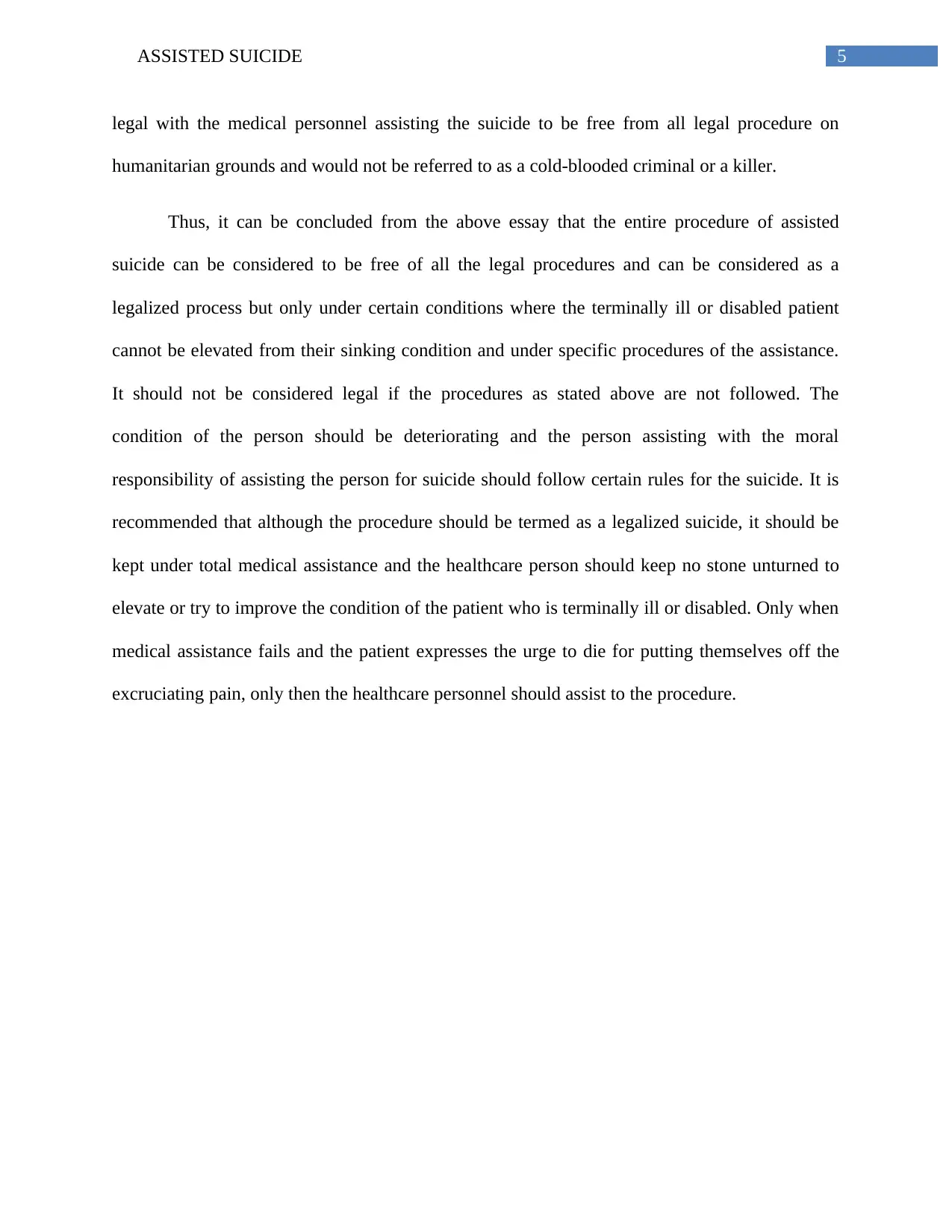
5ASSISTED SUICIDE
legal with the medical personnel assisting the suicide to be free from all legal procedure on
humanitarian grounds and would not be referred to as a cold-blooded criminal or a killer.
Thus, it can be concluded from the above essay that the entire procedure of assisted
suicide can be considered to be free of all the legal procedures and can be considered as a
legalized process but only under certain conditions where the terminally ill or disabled patient
cannot be elevated from their sinking condition and under specific procedures of the assistance.
It should not be considered legal if the procedures as stated above are not followed. The
condition of the person should be deteriorating and the person assisting with the moral
responsibility of assisting the person for suicide should follow certain rules for the suicide. It is
recommended that although the procedure should be termed as a legalized suicide, it should be
kept under total medical assistance and the healthcare person should keep no stone unturned to
elevate or try to improve the condition of the patient who is terminally ill or disabled. Only when
medical assistance fails and the patient expresses the urge to die for putting themselves off the
excruciating pain, only then the healthcare personnel should assist to the procedure.
legal with the medical personnel assisting the suicide to be free from all legal procedure on
humanitarian grounds and would not be referred to as a cold-blooded criminal or a killer.
Thus, it can be concluded from the above essay that the entire procedure of assisted
suicide can be considered to be free of all the legal procedures and can be considered as a
legalized process but only under certain conditions where the terminally ill or disabled patient
cannot be elevated from their sinking condition and under specific procedures of the assistance.
It should not be considered legal if the procedures as stated above are not followed. The
condition of the person should be deteriorating and the person assisting with the moral
responsibility of assisting the person for suicide should follow certain rules for the suicide. It is
recommended that although the procedure should be termed as a legalized suicide, it should be
kept under total medical assistance and the healthcare person should keep no stone unturned to
elevate or try to improve the condition of the patient who is terminally ill or disabled. Only when
medical assistance fails and the patient expresses the urge to die for putting themselves off the
excruciating pain, only then the healthcare personnel should assist to the procedure.
⊘ This is a preview!⊘
Do you want full access?
Subscribe today to unlock all pages.

Trusted by 1+ million students worldwide
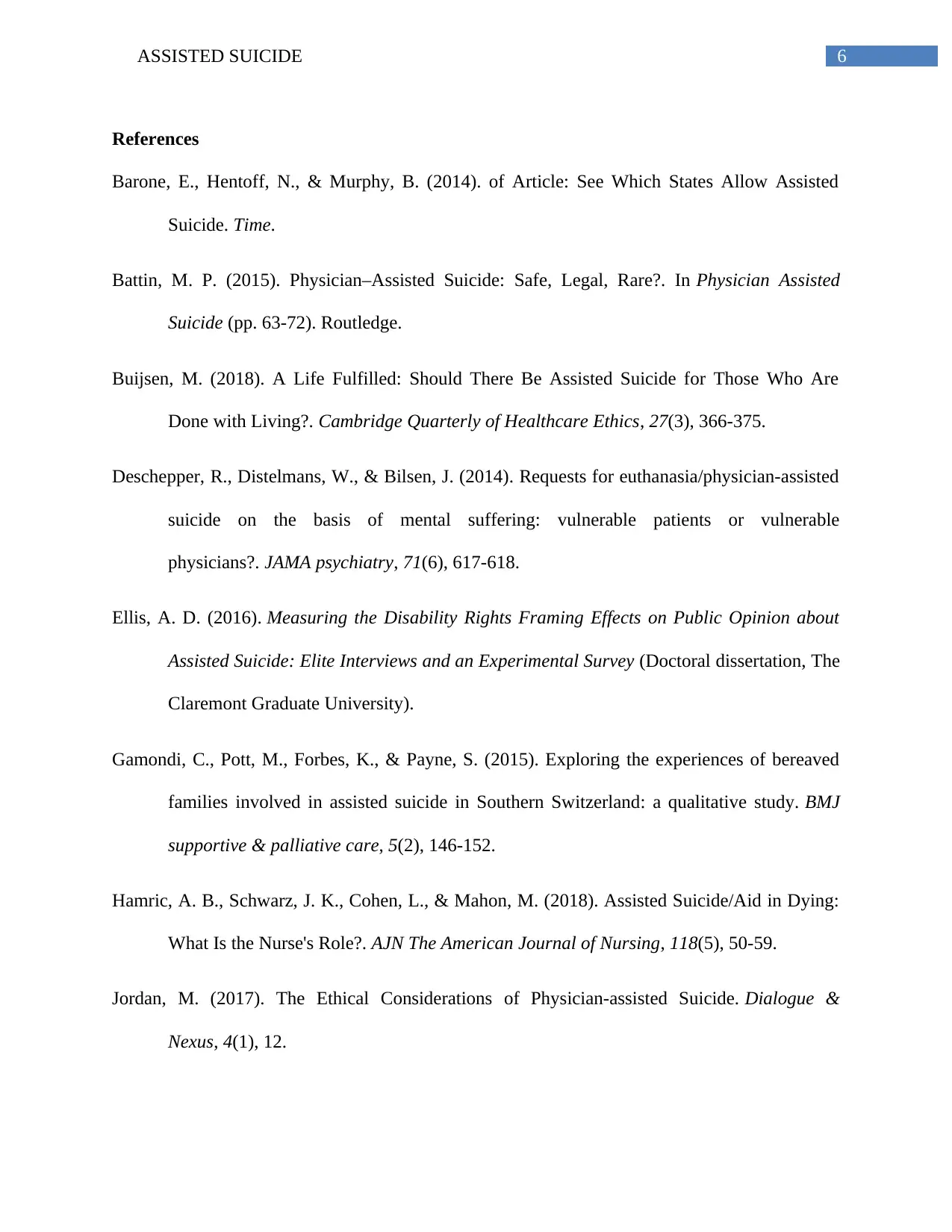
6ASSISTED SUICIDE
References
Barone, E., Hentoff, N., & Murphy, B. (2014). of Article: See Which States Allow Assisted
Suicide. Time.
Battin, M. P. (2015). Physician–Assisted Suicide: Safe, Legal, Rare?. In Physician Assisted
Suicide (pp. 63-72). Routledge.
Buijsen, M. (2018). A Life Fulfilled: Should There Be Assisted Suicide for Those Who Are
Done with Living?. Cambridge Quarterly of Healthcare Ethics, 27(3), 366-375.
Deschepper, R., Distelmans, W., & Bilsen, J. (2014). Requests for euthanasia/physician-assisted
suicide on the basis of mental suffering: vulnerable patients or vulnerable
physicians?. JAMA psychiatry, 71(6), 617-618.
Ellis, A. D. (2016). Measuring the Disability Rights Framing Effects on Public Opinion about
Assisted Suicide: Elite Interviews and an Experimental Survey (Doctoral dissertation, The
Claremont Graduate University).
Gamondi, C., Pott, M., Forbes, K., & Payne, S. (2015). Exploring the experiences of bereaved
families involved in assisted suicide in Southern Switzerland: a qualitative study. BMJ
supportive & palliative care, 5(2), 146-152.
Hamric, A. B., Schwarz, J. K., Cohen, L., & Mahon, M. (2018). Assisted Suicide/Aid in Dying:
What Is the Nurse's Role?. AJN The American Journal of Nursing, 118(5), 50-59.
Jordan, M. (2017). The Ethical Considerations of Physician-assisted Suicide. Dialogue &
Nexus, 4(1), 12.
References
Barone, E., Hentoff, N., & Murphy, B. (2014). of Article: See Which States Allow Assisted
Suicide. Time.
Battin, M. P. (2015). Physician–Assisted Suicide: Safe, Legal, Rare?. In Physician Assisted
Suicide (pp. 63-72). Routledge.
Buijsen, M. (2018). A Life Fulfilled: Should There Be Assisted Suicide for Those Who Are
Done with Living?. Cambridge Quarterly of Healthcare Ethics, 27(3), 366-375.
Deschepper, R., Distelmans, W., & Bilsen, J. (2014). Requests for euthanasia/physician-assisted
suicide on the basis of mental suffering: vulnerable patients or vulnerable
physicians?. JAMA psychiatry, 71(6), 617-618.
Ellis, A. D. (2016). Measuring the Disability Rights Framing Effects on Public Opinion about
Assisted Suicide: Elite Interviews and an Experimental Survey (Doctoral dissertation, The
Claremont Graduate University).
Gamondi, C., Pott, M., Forbes, K., & Payne, S. (2015). Exploring the experiences of bereaved
families involved in assisted suicide in Southern Switzerland: a qualitative study. BMJ
supportive & palliative care, 5(2), 146-152.
Hamric, A. B., Schwarz, J. K., Cohen, L., & Mahon, M. (2018). Assisted Suicide/Aid in Dying:
What Is the Nurse's Role?. AJN The American Journal of Nursing, 118(5), 50-59.
Jordan, M. (2017). The Ethical Considerations of Physician-assisted Suicide. Dialogue &
Nexus, 4(1), 12.
Paraphrase This Document
Need a fresh take? Get an instant paraphrase of this document with our AI Paraphraser
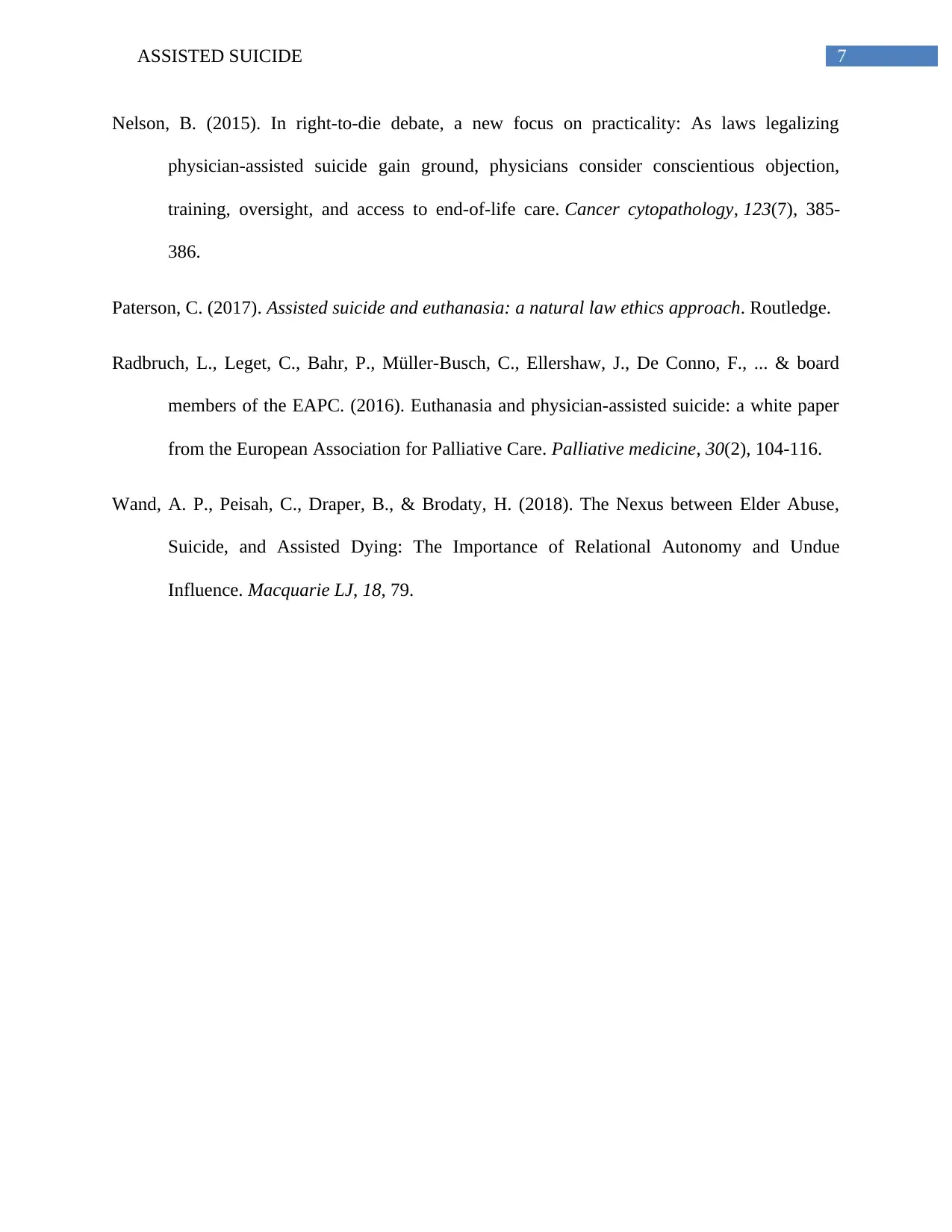
7ASSISTED SUICIDE
Nelson, B. (2015). In right‐to‐die debate, a new focus on practicality: As laws legalizing
physician‐assisted suicide gain ground, physicians consider conscientious objection,
training, oversight, and access to end‐of‐life care. Cancer cytopathology, 123(7), 385-
386.
Paterson, C. (2017). Assisted suicide and euthanasia: a natural law ethics approach. Routledge.
Radbruch, L., Leget, C., Bahr, P., Müller-Busch, C., Ellershaw, J., De Conno, F., ... & board
members of the EAPC. (2016). Euthanasia and physician-assisted suicide: a white paper
from the European Association for Palliative Care. Palliative medicine, 30(2), 104-116.
Wand, A. P., Peisah, C., Draper, B., & Brodaty, H. (2018). The Nexus between Elder Abuse,
Suicide, and Assisted Dying: The Importance of Relational Autonomy and Undue
Influence. Macquarie LJ, 18, 79.
Nelson, B. (2015). In right‐to‐die debate, a new focus on practicality: As laws legalizing
physician‐assisted suicide gain ground, physicians consider conscientious objection,
training, oversight, and access to end‐of‐life care. Cancer cytopathology, 123(7), 385-
386.
Paterson, C. (2017). Assisted suicide and euthanasia: a natural law ethics approach. Routledge.
Radbruch, L., Leget, C., Bahr, P., Müller-Busch, C., Ellershaw, J., De Conno, F., ... & board
members of the EAPC. (2016). Euthanasia and physician-assisted suicide: a white paper
from the European Association for Palliative Care. Palliative medicine, 30(2), 104-116.
Wand, A. P., Peisah, C., Draper, B., & Brodaty, H. (2018). The Nexus between Elder Abuse,
Suicide, and Assisted Dying: The Importance of Relational Autonomy and Undue
Influence. Macquarie LJ, 18, 79.
1 out of 8
Related Documents
Your All-in-One AI-Powered Toolkit for Academic Success.
+13062052269
info@desklib.com
Available 24*7 on WhatsApp / Email
![[object Object]](/_next/static/media/star-bottom.7253800d.svg)
Unlock your academic potential
Copyright © 2020–2025 A2Z Services. All Rights Reserved. Developed and managed by ZUCOL.





